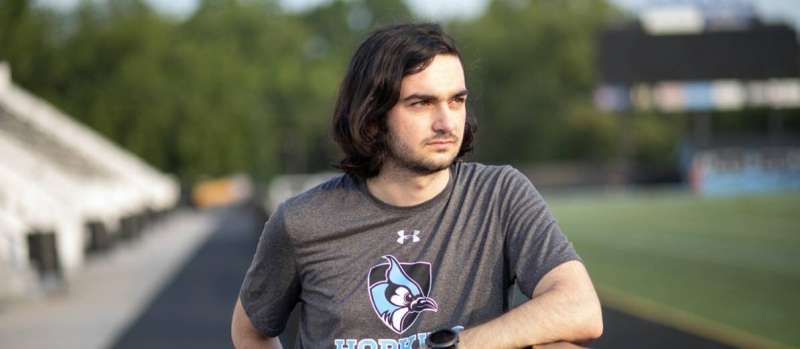
By early 2020, Chris Wilhelm was running up to 70 miles a week as a member of the Johns Hopkins cross country team.
Then, in June, the 20-year-old contracted a mild case of COVID-19, but he felt better within a couple of weeks and was back out running. By July, however, his cough returned and worsened. He felt lightheaded when he ran.
Nowadays, he’s lucky if he can make it through a 15-minute stroll without his heart rate skyrocketing to 170 beats per minute. After spending much of the past year on his parents’ sofa in Florida gaming and streaming videos, he returned to campus in August, where he’s supporting his team from the sidelines.
Wilhelm’s experience is not unique.
More than 5 million children and teens have tested positive for COVID-19 since the start of the pandemic. While about 30% of adult survivors report long-term symptoms, anywhere from 2% to 10% of young COVID-19 survivors—some as young as 9 years old—are estimated to experience lingering symptoms. Researchers are scrambling to find effective treatments and more accurately determine how widespread the condition is.
“We want to raise attention that it’s more than just death—we have people who have symptoms that linger with them for months on end, which can be just as devastating to families and individuals,” says epidemiologist Priya Duggal, a co-lead of the Johns Hopkins COVID Long Study.
Post-COVID-19 conditions, as defined by the Centers for Disease Control and Prevention, are a wide-ranging continuum of health problems that arise four or more weeks after being infected. Symptoms include breathing problems, diarrhea, joint pain, sleep problems, mood swings, rashes, and debilitating fatigue.
Peter Rowe, who is treating Wilhelm, suspected early in the pandemic that a wave of post-viral illnesses would follow. Around May 2020, appointment requests started coming in from patients like Wilhelm, and he now treats seven of them.
Most had had mild respiratory illnesses. Their lungs and heart checked out nearly perfect—but they were “completely flattened by fatigue, cognitive dysfunction, and lightheadedness,” says Rowe, director of the Chronic Fatigue Clinic at Johns Hopkins Children’s Center. “Those are some of the cardinal symptoms of chronic fatigue syndrome, and they’re turning out to be cardinal symptoms of long COVID.”
Rowe, who’s spent 25 years studying chronic fatigue syndrome, had often seen these post-viral symptoms in young mononucleosis patients. But with mono, the severity of the initial illness would predict chronic symptoms. With COVID-19, patients with mild initial infections might eventually meet the criteria for postural tachycardia syndrome, a form of chronic fatigue syndrome.
Working with Rowe, Wilhelm has tried some two dozen treatments, including sodium chloride (table salt), beta blockers, and sleeping pills—with uneven success.
On good days, Wilhelm thinks, “Am I being a big baby about this?” On others, when his heart is racing and he can’t get off the couch, he knows the answer is no.
“The stressors on the parents are just as great—if not greater—than on the kids,” says Alexandra Yonts, an infectious disease specialist and director of the Children’s National Post-COVID Program at Children’s National Hospital, which opened in May in Washington, D.C.
For one of Yonts’ patients, 17-year-old Alison Grant, things began to change soon after her mother recovered from COVID-19 in spring of 2020. Grant—an honors student and soccer goalie—began napping constantly and started rejecting foods she once loved. Steak, onions, tomatoes—even water—tasted rancid. In one smell test, she confused lemon with gasoline. It wasn’t until July that tests confirmed Alison, along with both her parents, had SARS-CoV-2 antibodies—though her twin sister did not.
Come August, when classes resumed: “No matter how much sleep I get I am, like, taking a two-hour nap after school,” says Grant.
With a strict regimen of Flonase and twice-daily smell training to retrain sensory nerve damage, certain foods are slowly becoming tolerable again. She ate a steak recently and considered it a victory. Since June, her energy levels have been improving.
A big concern for young people in particular: These are formative years. “We don’t know how it will affect their growth and development,” says Kelly Gebo, a professor of Medicine at the Johns Hopkins School of Medicine and a professor of Epidemiology at the Bloomberg School of Public Health.
Precious little research on kids and long COVID-19 has been done, so there are plenty of big open questions to answer, says Gebo. What is the clinical picture of COVID-19 at 12 weeks? At six months? What factors contribute to patients getting better—or not getting better—over time? Are they genetic factors in the host? Do they have to do with the virus itself—or the treatment of the initial infection?
Until research bears more fruit, physicians are focusing on managing each patient’s individual symptoms and goals. In Yonts’ clinic, an 11-year-old just wants to get back on the playground. For others, she is organizing specialized academic plans to help them get through the coming school year.
Yonts wants to make sure that all vulnerable kids who need treatment are getting it. Most of her patients—there are just seven so far—reached the clinic through personal connections. She’s sure many more desperate families are still seeking answers.
Source: Read Full Article
